2022年英语中考语法复习课件---冠词与数词(34张)
文档属性
| 名称 | 2022年英语中考语法复习课件---冠词与数词(34张) | 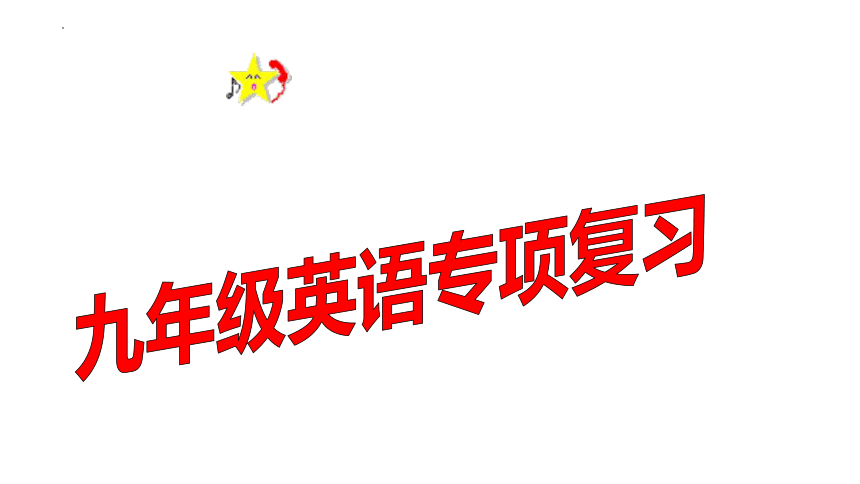 | |
| 格式 | pptx | ||
| 文件大小 | 570.5KB | ||
| 资源类型 | 教案 | ||
| 版本资源 | 通用版 | ||
| 科目 | 英语 | ||
| 更新时间 | 2022-05-11 12:49:03 | ||
图片预览

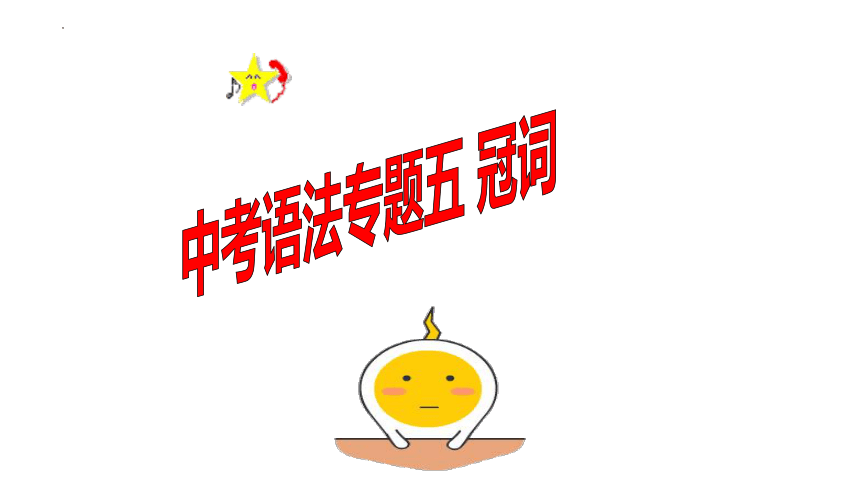
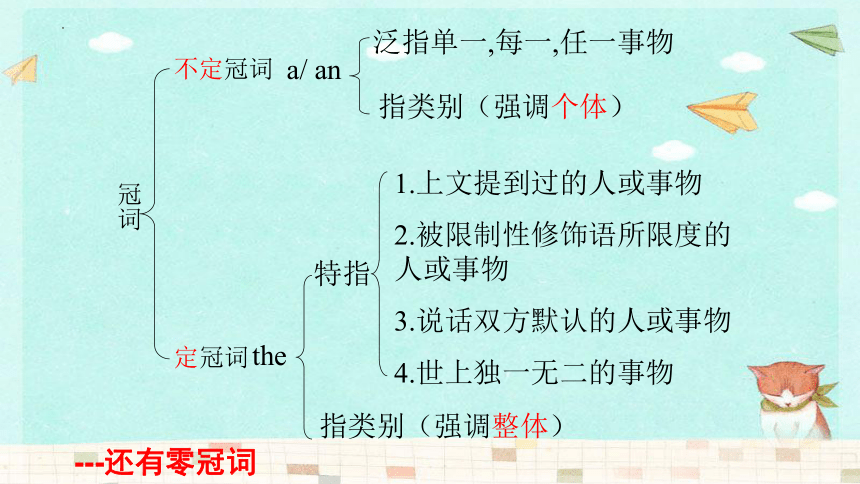
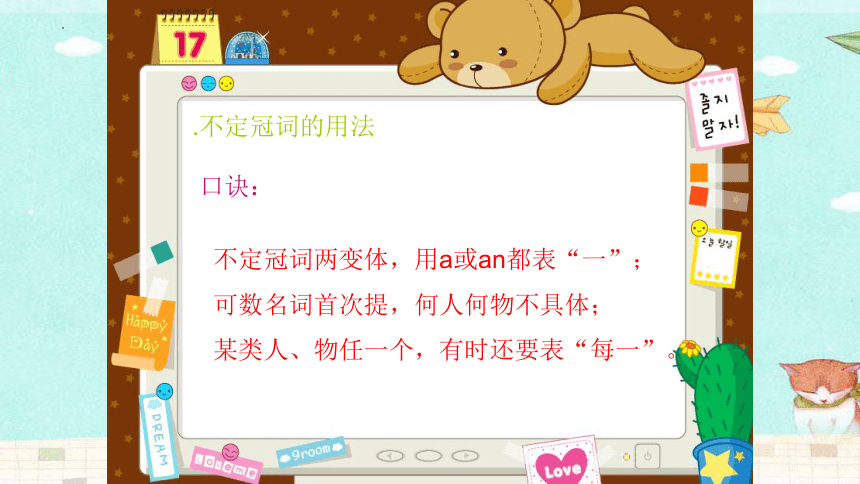
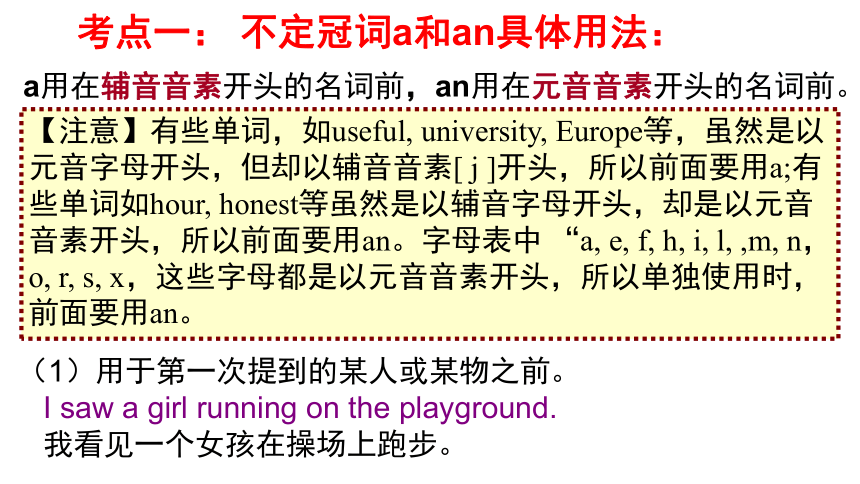
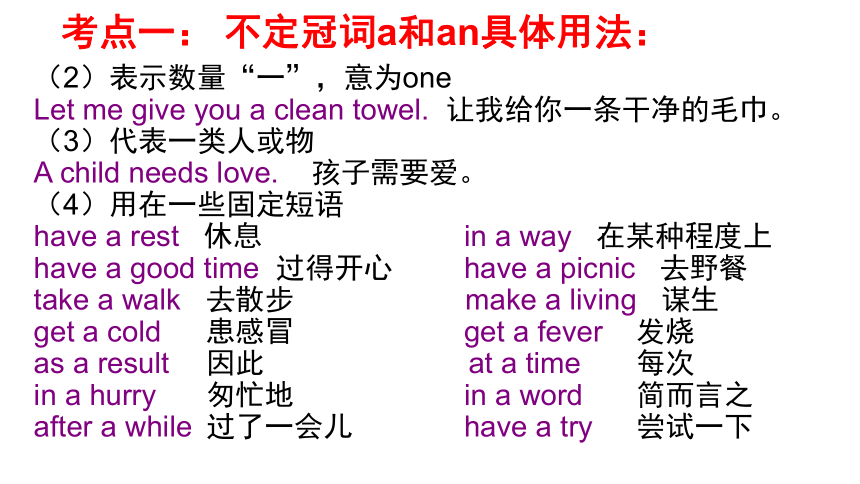

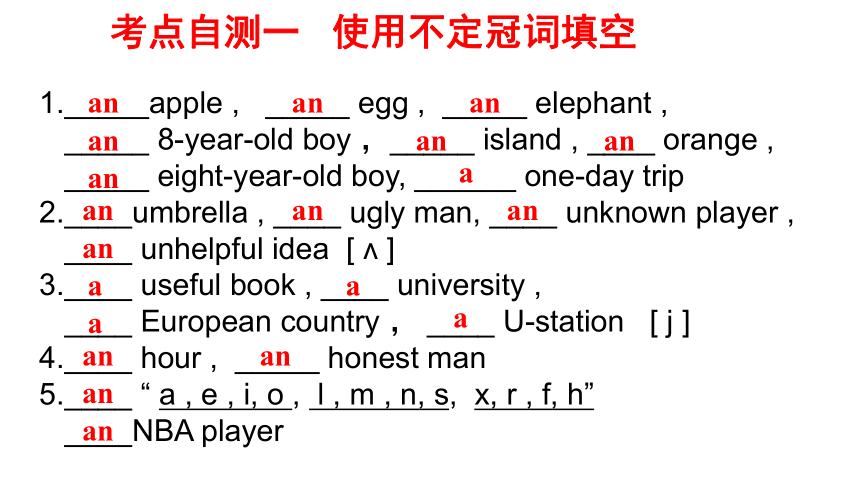
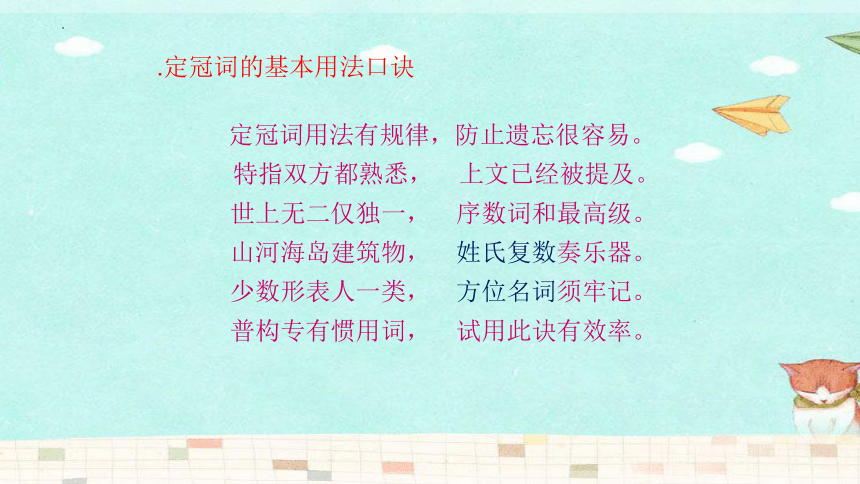
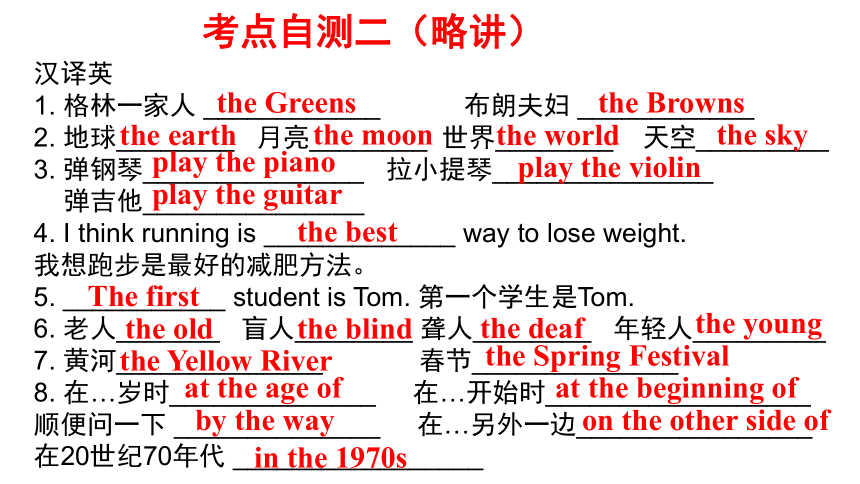
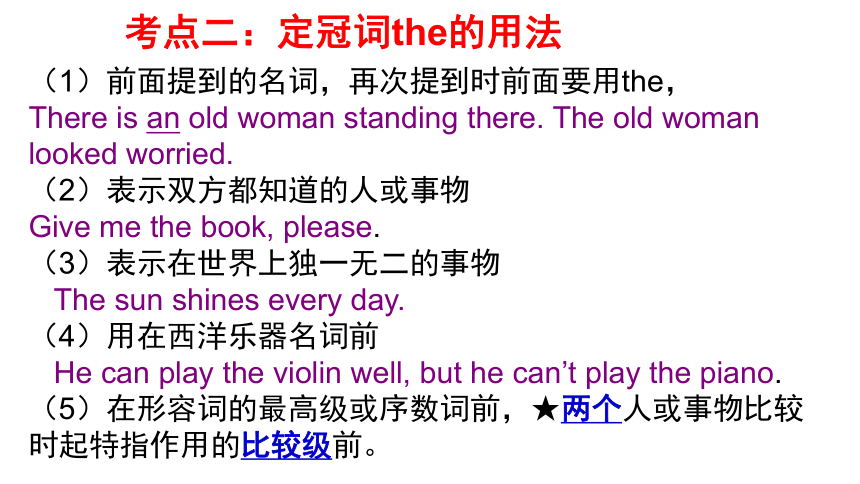
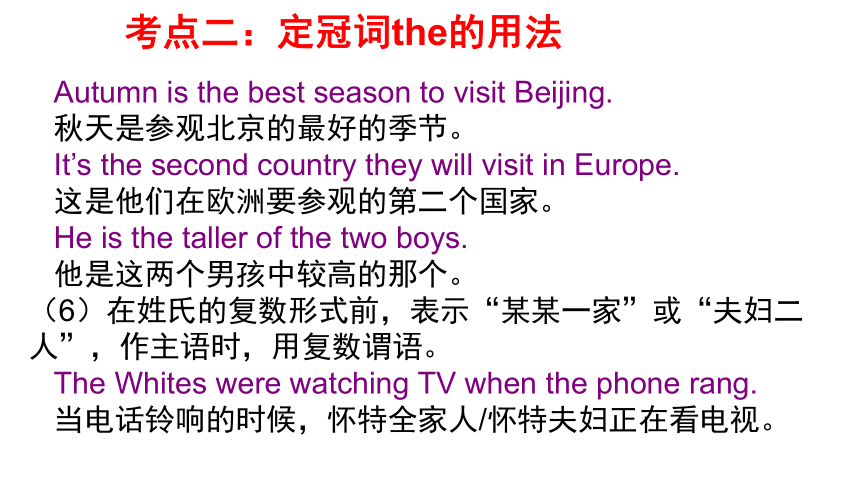
文档简介
(共34张PPT)
九年级英语专项复习
中考语法专题五 冠词
冠词
不定冠词
定冠词
a/ an
泛指单一,每一,任一事物
指类别(强调个体)
the
特指
指类别(强调整体)
1.上文提到过的人或事物
2.被限制性修饰语所限度的人或事物
3.说话双方默认的人或事物
4.世上独一无二的事物
---还有零冠词
.不定冠词的用法
口诀:
不定冠词两变体,用a或an都表“一”;
可数名词首次提,何人何物不具体;
某类人、物任一个,有时还要表“每一”。
考点一: 不定冠词a和an具体用法:
a用在辅音音素开头的名词前,an用在元音音素开头的名词前。
【注意】有些单词,如useful, university, Europe等,虽然是以元音字母开头,但却以辅音音素[ j ]开头,所以前面要用a;有些单词如hour, honest等虽然是以辅音字母开头,却是以元音音素开头,所以前面要用an。字母表中 “a, e, f, h, i, l, ,m, n,o, r, s, x,这些字母都是以元音音素开头,所以单独使用时,前面要用an。
(1)用于第一次提到的某人或某物之前。
I saw a girl running on the playground.
我看见一个女孩在操场上跑步。
考点一: 不定冠词a和an具体用法:
(2)表示数量“一”,意为one
Let me give you a clean towel. 让我给你一条干净的毛巾。
(3)代表一类人或物
A child needs love. 孩子需要爱。
(4)用在一些固定短语
have a rest 休息 in a way 在某种程度上
have a good time 过得开心 have a picnic 去野餐
take a walk 去散步 make a living 谋生
get a cold 患感冒 get a fever 发烧
as a result 因此 at a time 每次
in a hurry 匆忙地 in a word 简而言之
after a while 过了一会儿 have a try 尝试一下
考点一: 不定冠词a和an具体用法:
(5)用于可视为一体的两个名词前
a knife and fork 一副刀叉
(6)用在序数词前,表示“又一,再一”
She has failed three times. She wants to try a fourth time.
她已经失败了三次。她想再试一次。
(7)表示“每一”,相当于every
Take three pills a day and you’ll get better soon.
每天吃三片药,你很快就会好起来的。
1._____apple , _____ egg , _____ elephant ,
_____ 8-year-old boy ,_____ island , ____ orange ,
_____ eight-year-old boy, ______ one-day trip
2.____umbrella , ____ ugly man, ____ unknown player ,
____ unhelpful idea [ ]
3.____ useful book , ____ university ,
____ European country , ____ U-station [ j ]
4.____ hour , _____ honest man
5.____ “ a , e , i, o , l , m , n, s, x, r , f, h”
____NBA player
考点自测一 使用不定冠词填空
a
an
an
an
an
an
an
an
an
an
an
an
an
an
an
a
a
a
a
an
.定冠词的基本用法口诀
定冠词用法有规律,防止遗忘很容易。
特指双方都熟悉, 上文已经被提及。
世上无二仅独一, 序数词和最高级。
山河海岛建筑物, 姓氏复数奏乐器。
少数形表人一类, 方位名词须牢记。
普构专有惯用词, 试用此诀有效率。
考点自测二(略讲)
汉译英
1. 格林一家人 ____________ 布朗夫妇 ____________
2. 地球________ 月亮________ 世界________ 天空_________
3. 弹钢琴_______________ 拉小提琴_______________
弹吉他_______________
4. I think running is _____________ way to lose weight.
我想跑步是最好的减肥方法。
5. ___________ student is Tom. 第一个学生是Tom.
6. 老人_______ 盲人________ 聋人________ 年轻人_________
7. 黄河______________ 春节______________
8. 在…岁时______________ 在…开始时__________________
顺便问一下 ______________ 在…另外一边________________
在20世纪70年代 _________________
the best
the Greens
the Browns
the earth
play the piano
The first
the moon
the world
the sky
the old
at the age of
play the violin
play the guitar
the blind
the deaf
the young
the Yellow River
the Spring Festival
at the beginning of
by the way
on the other side of
in the 1970s
考点二:定冠词the的用法
(1)前面提到的名词,再次提到时前面要用the,
There is an old woman standing there. The old woman looked worried.
(2)表示双方都知道的人或事物
Give me the book, please.
(3)表示在世界上独一无二的事物
The sun shines every day.
(4)用在西洋乐器名词前
He can play the violin well, but he can’t play the piano.
(5)在形容词的最高级或序数词前,★两个人或事物比较时起特指作用的比较级前。
考点二:定冠词the的用法
Autumn is the best season to visit Beijing.
秋天是参观北京的最好的季节。
It’s the second country they will visit in Europe.
这是他们在欧洲要参观的第二个国家。
He is the taller of the two boys.
他是这两个男孩中较高的那个。
(6)在姓氏的复数形式前,表示“某某一家”或“夫妇二人”,作主语时,用复数谓语。
The Whites were watching TV when the phone rang.
当电话铃响的时候,怀特全家人/怀特夫妇正在看电视。
考点二:定冠词the的用法
(7)与形容词连用,表示一类人。
The poor are against the plan, but the rich are for it.
穷人反对这个计划,而富人先成。
(8)用于含有普通名词的专有名词前。
the Great Wall长城 the Changjiang River长江
(9)用在表示方向位置的名词前。
on the left 在左边
on the right 在右边
in the east/west/south/north of 在东/西/南/北方
in the centre of 在…中心
in the middle of 在…中间
考点二:定冠词the的用法
(10)用在某些习惯用语中。
in the morning(afternoon, evening) 在上午(下午、晚上)
go to the cinema看电影 in the way挡路
make the bed铺床 all the time一直
at the same time同时 the same as和……一样
in the end在最后 all the year round一年到头
on the way to前往……去的路上
on the Internet在网上 on the computer在电脑上
on the radio在收音机里 on the whole总的来看
hit sb in the face/ on the nose 打在某人脸上/鼻子上
.零冠词的基本用法口诀
歌曰:下列情况不用冠,代词限定名词前;
专有名词不可数,球类学科与三餐;
复数名词表泛指,节日月份星期前;
颜色语种和国名,称呼习语及头衔。
考点自测三(略略讲)
1.打羽毛球 ______________ 下棋 ______________
打排球 ______________ 吃早餐 ____________
吃中餐 ______________ 吃晚餐 ____________
2.在危险中 ______________ 步行 _____________
值日 ______________ 准时 ______________
及时 ______________ 乘地铁 ____________
下课后 ______________ 放学后 ____________
play badminton
play chess
play volleyball
have breakfast
have lunch
have supper
be in danger
on foot
on duty
on time
in time
after school
by subway
after class
考点三:零冠词的用法
(1) 人名,地名,国名前不用冠词。
Mary has been to China. 马丽去过中国深圳。
(2)在节日、日期、星期、季节、月份等表示时间的名词之前,不加冠词,特指的情况除外。
Children’s Day is on June 1st. 儿童节是6月1日。
Spring comes after winter. 春天在冬天过去之后到来。
We have classes from Monday to Friday.
我们从星期一到星期五都上课。
★the spring of 2012 2012年春天(特定)
★一些传统节日前
the Spring Festival 春节 the Lantern Festival 元霄节
the Dragon Boat Festival 端午节 the Mid-autumn Day 中秋节
考点三:零冠词的用法
(3)在学科、三餐、球类运动和棋类等前,不加冠词。注意: 当三餐前有形容词修饰时,应该加冠词。
English is my favorite subject. 英语是我们最喜欢的科目。
I had bread for breakfast this morning. But he went to school without breakfast.
今天早餐我吃了面包,但是他没吃早餐就去上学了
have a quick breakfast 快速地吃了早餐
(4)在称呼或表示头衔的名词前不加冠词。
This is Professor Li. 这是李教授。
(5)当by 与火车等交通工具连用,中间无冠词。
by bus 乘公共汽车 by plane/ by air乘飞机
by subway乘地铁
考点三:零冠词的用法
(6)名词前已有指示代词,物主代词,不定代词或名词所有格等修饰时,不用冠词
Today is my father’s fortieth birthday.
今天是我爸爸的40岁的生日。
(7) 固定短语或习惯用语
at night 在夜晚 at noon 在中午 at midnight 在午夜
at school 在学校 go to school 上学 go to church 去教堂
go to work 去上班 go to bed 睡觉 after school 放学后 after class 下课后 by chance 意外地 be in hospital 住院
catch fire 着火 for example 例如 in fact事实上 in case 以防万一 put into prison 送入监狱
考点四:某些固定短语中有无定冠词的区别
★有些个体名词不用冠词;如:school, college,prison, hospital, bed, table, class等个体名词,直接置于介词后,表示该名词的深层含义(某种行为)
无定冠词 有定冠词
at table在吃饭 at the table在桌子旁
in class 在上课 in the class在班级里
at/in school在上学 at/in the school在学校里(不一定是学生)
by sea乘船 by the sea在海边
in bed(睡、病、躺)在床上 in the bed在床上
in front of在(外部的)前面 in the front of在(内部的)前面
in hospital住院 in the hospital在医院里(不一定住院)
on earth究竟 on the Earth在地球上
in future今后 in the future将来
考点五:注意区别
(1)the + 序数词 “第几” a + 序数词 “又一,再一”
Today is his ninth birthday. 今天是他九岁生日。
I have read the novel twice. I want to read it a third time.
这篇小说我已经读了两遍。我想再读一遍。
(2) a number of一些
the number of …. 的数量(作主语用单数形式)
A number of students in our class like playing basketball.
我们班的一些学生喜欢打篮球。
The number of students is about 2,000 in our school.
我们学校大概有两千名学生。
(3) 半个小时 half an hour
一个半小时 one and a half hours = an hour and a half
第二部分 数词
数词的定义
数词的种类(基数词和序数词)
数词的实际运用
注意事项
练习
表示数目多少或顺序先后的词叫数词,数词分为基数词和序数词。表示数目多少的数词叫基数词;表示顺序的数词叫序数词。
1)基数词写法和读法:
345 three hundred and forty-five;
2)基数词一般是单数形式,但下列情况,常用复数:
a. 与of 短语连用,表示概数,不能与具体数目连 用,如hundreds of people 指许多人;
b. 在一些表示“一排”或“一组”的词组里;
如:They arrived in twos and threes. 他们三三两两的到达了。
c. 表示“几十岁”;
d. 表示“年代”,用 in +the +数词复数;
e. 在乘法运算的一种表示法里,
3 x 5 = 15 Three fives is (are) fifteen
基数词
序数词
序数词的缩写形式: first---1st second---2nd
数字 基数词 序数词 数字 基数词 序数词
1 one first 30 thirty thirtieth
2 two second 40 forty fortieth
3 three third 50 fifty fiftieth
5 five fifth 60 sixty sixtieth
8 eight eighth 70 seventy seventieth
9 nine ninth 80 eighty eightieth
12 twelve twelfth 90 ninety ninetieth
20 twenty twentieth 100 hundred hundredth
1)倍数表示法
a. 主语+谓语+倍数(或分数)+ as + adj. + as
I have three times as many as you. 我有你三倍那么多
b. 主语+谓语+倍数/分数+ the size (amount/length…) of…
The earth is 49 times the size of the moon.
地球是月球的49倍。
c. 主语+谓语+倍数/分数+形容词/副词比较级+than…
The grain output is 8 percent higher this year than that of last year. 今年比去年粮食产量增加8%。
d. 还可以用by+倍数,表示增加多少倍
The production of grain has been increased by four times this year. 今年粮食产量增加了4倍。
数词的实际运用
2)分数表示法
构成:基数词代表分子,序数词代表分母。分子大于1时,分子的序数词用单数,分母序数词用复数:
1/3 one-third ; 3 3/7 three and three-sevenths.
3)小数:
小数点读point, 0 读o 或zero, 小数点后的数字按个位基数词依次读出即可。
0.5 zero point five, 3.145 three point one four five
4) 百分数:
百分数由基数词+ percent 来表示。
3% three percent 56% fifty-six percent
5)数字运算
1+2=3 one plus two is three
5-4=1 five minus four is one
2×3 =6 two times three is six
two multiplied by three is six
8÷4=2 eight divided by four is two.
6)年、月、日的表示法
1990 Nineteen ninety
2000 (the year) two thousand
20世纪90年代 1990s nineteen nineties
7月1日 July the first; the first of July
7)时刻表示法:
情况 顺读法 示例
整点 基数词(+o’clock) 9:00 nine (o’clock)
几点零几分 钟点数(+O)+分钟数 9:05 nine (O) five
几点几十分 钟点数+分钟数 9:40 nine forty
情况 逆读法 示例
30分钟以内 分钟数+(minutes) past+钟点数 9:10
30分钟以外 到下一个钟点所差的分钟数+(minutes) + to+下一个钟点数 9:50
30分钟 half past + 钟点数 9:30
说明 使用逆读法时,15分,45分可以用a quarter表。示。如:9:45 a quarter to ten
注意事项
1)英语中表示基数单位的数词有:百( hundred ) ,千( thousand ),百万( million ),十亿( billion ),但没有万,十万,亿,要注意它们的表示法:
一百 (100) a hundred
一千 (1,000) a thousand
一万 (10,000) ten thousand
十万 (100,000) a hundred thousand
一百万 (1,000,000) a million (= a thousand thousand)
一千万 (10,000,000) ten million
一亿 (100,000,000) a hundred million
十亿 (1,000,000,000) a billion (= a thousand million)
2) hundred, thousand, million等表示基数单词的词前面有基数词,用来修饰后面的名词表示精确数量时,本身不用复数形式,名词才用复数形式.
如:两千人 two thousand people
三百米 three hundred meters
但在表示含糊数量时要用复数形式,并要与of 连用,构成hundreds of(数百的), thousands of(数千的或成千上万的), millions of (数百万的)
如: 数千人 thousands of people
3) 序数词在使用时,一般在其前面加定冠the或物主代词等限定词.
如:the first time 第一次
his second son 他的第二个儿子
如果序数词前加定冠词a/an,则表示“又一,再一”.
如:I’ve tried twice. And I want a third try.
4) 分数作主语时,谓语动词要根据分数后的名词来确定,如果不可数名词就要用单数,是可数名词则用复数.
如:One third of the students in our class have been to the Great Wall.
Four fifths of the water is drunk by the children.
1.There are _________________________ (365)days in a year.
2.Look!There are __________ (成千上万的) stars in the sky.
3. ______________ (2/3)of the students are girls in our class.
4.September is the __________ month of the year.
5.There are forty-six students in Class _______ (三班).
6.December is the _________ and last month of the year.
7. There are _________ students in our class, twenty boys and twenty girls.
8. Our teacher often tells us that work must come _____(第一) .
9. At the beginning of the ___________ (twenty) century,the world\'s population was about 1, 700 million.
用数词填空:(略讲)
three hundred and sixty-five
thousands of
Two thirds
ninth
Three
twelfth
forty
first
twentieth
九年级英语专项复习
中考语法专题五 冠词
冠词
不定冠词
定冠词
a/ an
泛指单一,每一,任一事物
指类别(强调个体)
the
特指
指类别(强调整体)
1.上文提到过的人或事物
2.被限制性修饰语所限度的人或事物
3.说话双方默认的人或事物
4.世上独一无二的事物
---还有零冠词
.不定冠词的用法
口诀:
不定冠词两变体,用a或an都表“一”;
可数名词首次提,何人何物不具体;
某类人、物任一个,有时还要表“每一”。
考点一: 不定冠词a和an具体用法:
a用在辅音音素开头的名词前,an用在元音音素开头的名词前。
【注意】有些单词,如useful, university, Europe等,虽然是以元音字母开头,但却以辅音音素[ j ]开头,所以前面要用a;有些单词如hour, honest等虽然是以辅音字母开头,却是以元音音素开头,所以前面要用an。字母表中 “a, e, f, h, i, l, ,m, n,o, r, s, x,这些字母都是以元音音素开头,所以单独使用时,前面要用an。
(1)用于第一次提到的某人或某物之前。
I saw a girl running on the playground.
我看见一个女孩在操场上跑步。
考点一: 不定冠词a和an具体用法:
(2)表示数量“一”,意为one
Let me give you a clean towel. 让我给你一条干净的毛巾。
(3)代表一类人或物
A child needs love. 孩子需要爱。
(4)用在一些固定短语
have a rest 休息 in a way 在某种程度上
have a good time 过得开心 have a picnic 去野餐
take a walk 去散步 make a living 谋生
get a cold 患感冒 get a fever 发烧
as a result 因此 at a time 每次
in a hurry 匆忙地 in a word 简而言之
after a while 过了一会儿 have a try 尝试一下
考点一: 不定冠词a和an具体用法:
(5)用于可视为一体的两个名词前
a knife and fork 一副刀叉
(6)用在序数词前,表示“又一,再一”
She has failed three times. She wants to try a fourth time.
她已经失败了三次。她想再试一次。
(7)表示“每一”,相当于every
Take three pills a day and you’ll get better soon.
每天吃三片药,你很快就会好起来的。
1._____apple , _____ egg , _____ elephant ,
_____ 8-year-old boy ,_____ island , ____ orange ,
_____ eight-year-old boy, ______ one-day trip
2.____umbrella , ____ ugly man, ____ unknown player ,
____ unhelpful idea [ ]
3.____ useful book , ____ university ,
____ European country , ____ U-station [ j ]
4.____ hour , _____ honest man
5.____ “ a , e , i, o , l , m , n, s, x, r , f, h”
____NBA player
考点自测一 使用不定冠词填空
a
an
an
an
an
an
an
an
an
an
an
an
an
an
an
a
a
a
a
an
.定冠词的基本用法口诀
定冠词用法有规律,防止遗忘很容易。
特指双方都熟悉, 上文已经被提及。
世上无二仅独一, 序数词和最高级。
山河海岛建筑物, 姓氏复数奏乐器。
少数形表人一类, 方位名词须牢记。
普构专有惯用词, 试用此诀有效率。
考点自测二(略讲)
汉译英
1. 格林一家人 ____________ 布朗夫妇 ____________
2. 地球________ 月亮________ 世界________ 天空_________
3. 弹钢琴_______________ 拉小提琴_______________
弹吉他_______________
4. I think running is _____________ way to lose weight.
我想跑步是最好的减肥方法。
5. ___________ student is Tom. 第一个学生是Tom.
6. 老人_______ 盲人________ 聋人________ 年轻人_________
7. 黄河______________ 春节______________
8. 在…岁时______________ 在…开始时__________________
顺便问一下 ______________ 在…另外一边________________
在20世纪70年代 _________________
the best
the Greens
the Browns
the earth
play the piano
The first
the moon
the world
the sky
the old
at the age of
play the violin
play the guitar
the blind
the deaf
the young
the Yellow River
the Spring Festival
at the beginning of
by the way
on the other side of
in the 1970s
考点二:定冠词the的用法
(1)前面提到的名词,再次提到时前面要用the,
There is an old woman standing there. The old woman looked worried.
(2)表示双方都知道的人或事物
Give me the book, please.
(3)表示在世界上独一无二的事物
The sun shines every day.
(4)用在西洋乐器名词前
He can play the violin well, but he can’t play the piano.
(5)在形容词的最高级或序数词前,★两个人或事物比较时起特指作用的比较级前。
考点二:定冠词the的用法
Autumn is the best season to visit Beijing.
秋天是参观北京的最好的季节。
It’s the second country they will visit in Europe.
这是他们在欧洲要参观的第二个国家。
He is the taller of the two boys.
他是这两个男孩中较高的那个。
(6)在姓氏的复数形式前,表示“某某一家”或“夫妇二人”,作主语时,用复数谓语。
The Whites were watching TV when the phone rang.
当电话铃响的时候,怀特全家人/怀特夫妇正在看电视。
考点二:定冠词the的用法
(7)与形容词连用,表示一类人。
The poor are against the plan, but the rich are for it.
穷人反对这个计划,而富人先成。
(8)用于含有普通名词的专有名词前。
the Great Wall长城 the Changjiang River长江
(9)用在表示方向位置的名词前。
on the left 在左边
on the right 在右边
in the east/west/south/north of 在东/西/南/北方
in the centre of 在…中心
in the middle of 在…中间
考点二:定冠词the的用法
(10)用在某些习惯用语中。
in the morning(afternoon, evening) 在上午(下午、晚上)
go to the cinema看电影 in the way挡路
make the bed铺床 all the time一直
at the same time同时 the same as和……一样
in the end在最后 all the year round一年到头
on the way to前往……去的路上
on the Internet在网上 on the computer在电脑上
on the radio在收音机里 on the whole总的来看
hit sb in the face/ on the nose 打在某人脸上/鼻子上
.零冠词的基本用法口诀
歌曰:下列情况不用冠,代词限定名词前;
专有名词不可数,球类学科与三餐;
复数名词表泛指,节日月份星期前;
颜色语种和国名,称呼习语及头衔。
考点自测三(略略讲)
1.打羽毛球 ______________ 下棋 ______________
打排球 ______________ 吃早餐 ____________
吃中餐 ______________ 吃晚餐 ____________
2.在危险中 ______________ 步行 _____________
值日 ______________ 准时 ______________
及时 ______________ 乘地铁 ____________
下课后 ______________ 放学后 ____________
play badminton
play chess
play volleyball
have breakfast
have lunch
have supper
be in danger
on foot
on duty
on time
in time
after school
by subway
after class
考点三:零冠词的用法
(1) 人名,地名,国名前不用冠词。
Mary has been to China. 马丽去过中国深圳。
(2)在节日、日期、星期、季节、月份等表示时间的名词之前,不加冠词,特指的情况除外。
Children’s Day is on June 1st. 儿童节是6月1日。
Spring comes after winter. 春天在冬天过去之后到来。
We have classes from Monday to Friday.
我们从星期一到星期五都上课。
★the spring of 2012 2012年春天(特定)
★一些传统节日前
the Spring Festival 春节 the Lantern Festival 元霄节
the Dragon Boat Festival 端午节 the Mid-autumn Day 中秋节
考点三:零冠词的用法
(3)在学科、三餐、球类运动和棋类等前,不加冠词。注意: 当三餐前有形容词修饰时,应该加冠词。
English is my favorite subject. 英语是我们最喜欢的科目。
I had bread for breakfast this morning. But he went to school without breakfast.
今天早餐我吃了面包,但是他没吃早餐就去上学了
have a quick breakfast 快速地吃了早餐
(4)在称呼或表示头衔的名词前不加冠词。
This is Professor Li. 这是李教授。
(5)当by 与火车等交通工具连用,中间无冠词。
by bus 乘公共汽车 by plane/ by air乘飞机
by subway乘地铁
考点三:零冠词的用法
(6)名词前已有指示代词,物主代词,不定代词或名词所有格等修饰时,不用冠词
Today is my father’s fortieth birthday.
今天是我爸爸的40岁的生日。
(7) 固定短语或习惯用语
at night 在夜晚 at noon 在中午 at midnight 在午夜
at school 在学校 go to school 上学 go to church 去教堂
go to work 去上班 go to bed 睡觉 after school 放学后 after class 下课后 by chance 意外地 be in hospital 住院
catch fire 着火 for example 例如 in fact事实上 in case 以防万一 put into prison 送入监狱
考点四:某些固定短语中有无定冠词的区别
★有些个体名词不用冠词;如:school, college,prison, hospital, bed, table, class等个体名词,直接置于介词后,表示该名词的深层含义(某种行为)
无定冠词 有定冠词
at table在吃饭 at the table在桌子旁
in class 在上课 in the class在班级里
at/in school在上学 at/in the school在学校里(不一定是学生)
by sea乘船 by the sea在海边
in bed(睡、病、躺)在床上 in the bed在床上
in front of在(外部的)前面 in the front of在(内部的)前面
in hospital住院 in the hospital在医院里(不一定住院)
on earth究竟 on the Earth在地球上
in future今后 in the future将来
考点五:注意区别
(1)the + 序数词 “第几” a + 序数词 “又一,再一”
Today is his ninth birthday. 今天是他九岁生日。
I have read the novel twice. I want to read it a third time.
这篇小说我已经读了两遍。我想再读一遍。
(2) a number of一些
the number of …. 的数量(作主语用单数形式)
A number of students in our class like playing basketball.
我们班的一些学生喜欢打篮球。
The number of students is about 2,000 in our school.
我们学校大概有两千名学生。
(3) 半个小时 half an hour
一个半小时 one and a half hours = an hour and a half
第二部分 数词
数词的定义
数词的种类(基数词和序数词)
数词的实际运用
注意事项
练习
表示数目多少或顺序先后的词叫数词,数词分为基数词和序数词。表示数目多少的数词叫基数词;表示顺序的数词叫序数词。
1)基数词写法和读法:
345 three hundred and forty-five;
2)基数词一般是单数形式,但下列情况,常用复数:
a. 与of 短语连用,表示概数,不能与具体数目连 用,如hundreds of people 指许多人;
b. 在一些表示“一排”或“一组”的词组里;
如:They arrived in twos and threes. 他们三三两两的到达了。
c. 表示“几十岁”;
d. 表示“年代”,用 in +the +数词复数;
e. 在乘法运算的一种表示法里,
3 x 5 = 15 Three fives is (are) fifteen
基数词
序数词
序数词的缩写形式: first---1st second---2nd
数字 基数词 序数词 数字 基数词 序数词
1 one first 30 thirty thirtieth
2 two second 40 forty fortieth
3 three third 50 fifty fiftieth
5 five fifth 60 sixty sixtieth
8 eight eighth 70 seventy seventieth
9 nine ninth 80 eighty eightieth
12 twelve twelfth 90 ninety ninetieth
20 twenty twentieth 100 hundred hundredth
1)倍数表示法
a. 主语+谓语+倍数(或分数)+ as + adj. + as
I have three times as many as you. 我有你三倍那么多
b. 主语+谓语+倍数/分数+ the size (amount/length…) of…
The earth is 49 times the size of the moon.
地球是月球的49倍。
c. 主语+谓语+倍数/分数+形容词/副词比较级+than…
The grain output is 8 percent higher this year than that of last year. 今年比去年粮食产量增加8%。
d. 还可以用by+倍数,表示增加多少倍
The production of grain has been increased by four times this year. 今年粮食产量增加了4倍。
数词的实际运用
2)分数表示法
构成:基数词代表分子,序数词代表分母。分子大于1时,分子的序数词用单数,分母序数词用复数:
1/3 one-third ; 3 3/7 three and three-sevenths.
3)小数:
小数点读point, 0 读o 或zero, 小数点后的数字按个位基数词依次读出即可。
0.5 zero point five, 3.145 three point one four five
4) 百分数:
百分数由基数词+ percent 来表示。
3% three percent 56% fifty-six percent
5)数字运算
1+2=3 one plus two is three
5-4=1 five minus four is one
2×3 =6 two times three is six
two multiplied by three is six
8÷4=2 eight divided by four is two.
6)年、月、日的表示法
1990 Nineteen ninety
2000 (the year) two thousand
20世纪90年代 1990s nineteen nineties
7月1日 July the first; the first of July
7)时刻表示法:
情况 顺读法 示例
整点 基数词(+o’clock) 9:00 nine (o’clock)
几点零几分 钟点数(+O)+分钟数 9:05 nine (O) five
几点几十分 钟点数+分钟数 9:40 nine forty
情况 逆读法 示例
30分钟以内 分钟数+(minutes) past+钟点数 9:10
30分钟以外 到下一个钟点所差的分钟数+(minutes) + to+下一个钟点数 9:50
30分钟 half past + 钟点数 9:30
说明 使用逆读法时,15分,45分可以用a quarter表。示。如:9:45 a quarter to ten
注意事项
1)英语中表示基数单位的数词有:百( hundred ) ,千( thousand ),百万( million ),十亿( billion ),但没有万,十万,亿,要注意它们的表示法:
一百 (100) a hundred
一千 (1,000) a thousand
一万 (10,000) ten thousand
十万 (100,000) a hundred thousand
一百万 (1,000,000) a million (= a thousand thousand)
一千万 (10,000,000) ten million
一亿 (100,000,000) a hundred million
十亿 (1,000,000,000) a billion (= a thousand million)
2) hundred, thousand, million等表示基数单词的词前面有基数词,用来修饰后面的名词表示精确数量时,本身不用复数形式,名词才用复数形式.
如:两千人 two thousand people
三百米 three hundred meters
但在表示含糊数量时要用复数形式,并要与of 连用,构成hundreds of(数百的), thousands of(数千的或成千上万的), millions of (数百万的)
如: 数千人 thousands of people
3) 序数词在使用时,一般在其前面加定冠the或物主代词等限定词.
如:the first time 第一次
his second son 他的第二个儿子
如果序数词前加定冠词a/an,则表示“又一,再一”.
如:I’ve tried twice. And I want a third try.
4) 分数作主语时,谓语动词要根据分数后的名词来确定,如果不可数名词就要用单数,是可数名词则用复数.
如:One third of the students in our class have been to the Great Wall.
Four fifths of the water is drunk by the children.
1.There are _________________________ (365)days in a year.
2.Look!There are __________ (成千上万的) stars in the sky.
3. ______________ (2/3)of the students are girls in our class.
4.September is the __________ month of the year.
5.There are forty-six students in Class _______ (三班).
6.December is the _________ and last month of the year.
7. There are _________ students in our class, twenty boys and twenty girls.
8. Our teacher often tells us that work must come _____(第一) .
9. At the beginning of the ___________ (twenty) century,the world\'s population was about 1, 700 million.
用数词填空:(略讲)
three hundred and sixty-five
thousands of
Two thirds
ninth
Three
twelfth
forty
first
twentieth
同课章节目录
- 词法
- 名词
- 动词和动词短语
- 动词语态
- 动词时态
- 助动词和情态动词
- 非谓语动词
- 冠词
- 代词
- 数词和量词
- 形容词副词及其比较等级
- 介词和介词短语
- 连词和感叹词
- 构词法
- 相似、相近词比较
- 句法
- 陈述句
- 一般疑问句和否定疑问句
- 特殊疑问句及选择疑问句
- 反意疑问句
- 存在句(There be句型)
- 宾语从句
- 定语从句
- 状语从句
- 主谓一致问题
- 简单句
- 并列句
- 复合句
- 主谓一致
- 主、表语从句
- 名词性从句
- 直接引语和间接引语
- 虚拟语气
- 感叹句
- 强调句
- 倒装句
- 祈使句
- 句子的成分
- 句子的分类
- 题型专区
- 单项选择部分
- 易错题
- 完形填空
- 阅读理解
- 词汇练习
- 听说训练
- 句型转换
- 补全对话
- 短文改错
- 翻译
- 书面表达
- 任务型阅读
- 语法填空
- 其他资料
